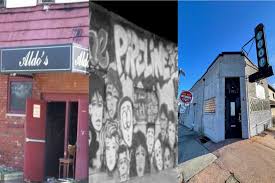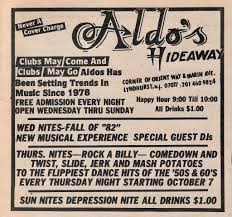The Legendary Beat: Aldo's Hideaway Dance Club in Lyndhurst, NJ
In the heart of Lyndhurst, New Jersey, at 749 Marin Avenue, stood a beacon of nightlife that pulsed with the rhythms of an era defined by new wave, punk, and alternative music. Aldo's Hideaway, often simply called Aldo's Dance Club, wasn't just a venue—it was a cultural epicenter for young revelers in the late 1970s and throughout the 1980s. From its humble beginnings as a restaurant to its transformation into a cutting-edge dance haven, the club captured the spirit of rebellion and joy that characterized the post-disco decade. Around 1980, as synthesizers and electric guitars dominated the airwaves, Aldo's became synonymous with unforgettable nights, where music lovers from across New Jersey converged to dance, connect, and escape. This article delves into the rich history of Aldo's Hideaway, focusing on its golden years around 1980, drawing from personal anecdotes, historical accounts, and the enduring legacy that still echoes in reunions today.
Origins: From Restaurant Roots to Nightclub Revolution
The story of Aldo's Hideaway begins with its visionary owner, Aldo Virginio. Born on August 21, 1958, in Woodland Park, NJ, Virginio was a local through and through. A graduate of Lyndhurst High School in 1976, where he excelled in football and wrestling, he developed an early passion for the food and service industry. As a teenager, he commuted to New York City on weekends to work as a chef at Gian Marino’s Restaurant, sharpening his skills in hospitality. By the late 1970s, Virginio channeled this experience into opening Aldo's Hideaway initially as a restaurant. However, recognizing the shifting tides of entertainment, he swiftly transitioned it into a vibrant nightclub in 1977.
The timing couldn't have been more perfect. The disco era was waning, and a new wave of music—pun intended—was surging. Virginio, with his entrepreneurial spirit, positioned Aldo's as a trendsetter. The club's tagline, emblazoned on vintage ads, boasted: "If you want to know what you'll be listening to tomorrow—come to Aldo's tonight." No cover charge on many nights made it accessible, drawing crowds eager for something fresh. By 1980, Aldo's had solidified its reputation as "The Best Dance Club in New Jersey," setting trends in music since 1978 with acts that foreshadowed the MTV generation.
Virginio's personal touch was evident from the start. Married to Dawn Marie Scelfo in 1980—the same year the club hit its stride—he balanced family life with business acumen. His devotion extended to the club, where he was known as a "cool and nice man" who occasionally enforced rules with vigor, like chasing underage patrons but later welcoming them back with a smile once they were legal. This blend of firmness and warmth helped foster a loyal community.
The 1980s Boom: Music, Atmosphere, and the Dance Floor Pulse
Around 1980, Aldo's Hideaway was at its zenith, embodying the eclectic energy of the early 1980s music scene. The club specialized in alternative and new wave genres, filling the air with tracks from artists like The Cure, Culture Club, Haysi Fantayzee, and David Bowie. Live performances were a hallmark, with legendary acts gracing the stage. In 1980 alone, The Stranglers delivered a unforgettable set, alongside other luminaries like Joan Jett (1979), The Rockets (1979), Speedies (1979), Psychedelic Furs (1980), and The Bangs (1980). These shows weren't just concerts; they were cultural events that introduced New Jersey audiences to sounds that would soon dominate global charts.
The atmosphere was electric yet intimate. Patrons entered a dimly lit space shrouded in smoky haze, with walls adorned with band posters and memorabilia. The dance floor throbbed under strobe lights, while the bar served as a social hub. Themed nights—goth evenings, punk rock fests, and hardcore Thursdays—kept things dynamic. DJs like Brian, a skinny figure with a bat tattoo and Bowie-inspired style, spun records on Saturday nights, creating magical moments. One memorable evening in 1983 saw DJ Brian dedicating David Bowie tracks to a young patron's birthday, even joining the dance floor for a personal wish.
Aldo's was inclusive, often bending rules for underage enthusiasts in an era without strict "all-ages" policies. Stories abound of teens sneaking in with fake IDs to catch bands starting at 2 a.m., only to be gently monitored by staff who ensured their safety. This welcoming vibe bridged generations, uniting "kids" and adults through shared love of music. However, it wasn't without its edge—recollections from patrons note crowds, drugs, and occasional chaos, though fights were rare compared to other spots.
The club's influence extended beyond Lyndhurst. It was part of a broader North Jersey nightlife tapestry, rivaling venues like Malibu or Connections in Clifton. Radio commercials on stations like WNEW and LIR hyped it as a must-visit, drawing crowds from Bergen County and beyond. For many, Aldo's was a rite of passage, where big hair, bold fashion, and boundary-pushing tunes defined youth.
Notable Events and Personal Tales: Nights to Remember
The early 1980s brimmed with standout moments at Aldo's. The Stranglers' 1980 performance stands out as a pinnacle, energizing the crowd with their punk-infused energy. Personal stories paint vivid pictures: one regular recalls decorating her room with fashion ads before heading out in 1983 with "80's hair" for a night of dancing. Another anecdote involves Virginio himself allowing poetry readings in the early 1990s, showcasing the club's evolution into a multifaceted space.
Reunions underscore these memories. Even after closure, alumni gather at places like Dingbatz in Clifton for "Aldo's Wave Night," celebrating the new wave and 80s vibes that defined the club. Facebook groups and X (formerly Twitter) posts from as early as 2013 evoke nostalgia, with users asking, "Does anyone remember Aldo's Hideaway?" and sharing tales of its punk and new wave glory.
Cultural Impact: A Melting Pot of Community and Legacy
Aldo's Hideaway wasn't merely a dance club; it was a sanctuary fostering lifelong friendships and a sense of belonging. In an era of cultural shifts, it provided a platform for diverse styles and personalities, influencing the local music scene profoundly. Patrons from all walks—teens, young adults, and even those crossing into NYC's edgier venues like CBGB—found common ground here. Its commitment to emerging talent helped propel acts that shaped the 80s soundtrack.
The club's impact lingers. Virginio expanded his empire to other venues like The Cavern in NYC, but Aldo's remained his flagship. Sadly, a devastating fire in August 2004 razed the building, displacing residents and marking the end of an era. Today, townhomes occupy the site, but the spirit endures through online communities and events.
Decline, Closure, and Enduring Echoes
By the early 2000s, changing tastes and regulations challenged Aldo's. The 2004 fire was the final blow, but Virginio's legacy continued. He pivoted to funeral directing in 2007, viewing it as another way to celebrate life—a poetic extension of his hospitality roots. Virginio passed away on July 21, 2024, at 65, after battling cancer, leaving a void but inspiring tributes.
Yet, Aldo's lives on. Reunions at Dingbatz keep the music playing, and stories shared on social media ensure new generations hear about this Lyndhurst gem. Around 1980, it wasn't just a club—it was the heartbeat of a movement.
In retrospect, Aldo's Hideaway encapsulated the 1980s' vibrancy: innovative, inclusive, and irreverent. Whether you were there dancing to The Stranglers or discovering new wave for the first time, it offered a slice of eternity in every beat. As one patron put it, "Aldo's had an amazing scene!"—a sentiment that resonates eternally.














Comments
Post a Comment